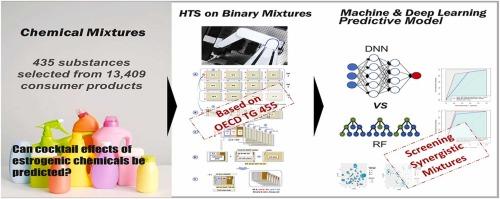Development of a deep neural network model based on high throughput screening data for predicting synergistic estrogenic activity of binary mixtures for consumer products
IF 12.2
1区 环境科学与生态学
Q1 ENGINEERING, ENVIRONMENTAL
引用次数: 0
Abstract
A paradigm of chemical risk assessment is continuously extending from focusing on ‘single substances’ to more comprehensive approaches that examines the combined toxicity among different components in ‘mixtures.’ This change aims to account for the cocktail effect arising from the toxicological interactions in mixtures, which can lead to increased risks. More than 1,000 potential endocrine-disrupting chemicals (EDCs) have been reported, and they can be included in different industrial and consumer chemical products and released to the environment as pollutants of emerging environmental concern. Although extensive studies involving both experiments and predictions have investigated individual EDCs, predictions of their synergistic effects are still relatively lacking, an area that requires further investigation. In this study, we extensively investigated substances in consumer products, mainly marketed in South Korea, that might exhibit estrogenic activity or reproductive toxicity. A high throughput screening (HTS) assay based on OECD Test Guideline 455 for hERαHeLa-9903 cells was constructed, and 435 substances were screened using the HTS. Thirty-five (potential) estrogenic agonists were selected, and their 1,412 binary mixtures that could be prepared in four different ratios were systematically tested, considering the available effective concentrations of substances and the solubility of their resulting mixtures. The best empirical dose-response curves of 35 substances and 917 mixtures were derived in this study. Based on the HTS data, a deep neural network model was developed (area under the curve (AUC): 0.837-0.881) and compared with a random forest model (AUC: 0.656-0.829) to screen for the synergistic estrogenic activity of binary mixtures.

求助全文
约1分钟内获得全文
求助全文
来源期刊

Journal of Hazardous Materials
工程技术-工程:环境
CiteScore
25.40
自引率
5.90%
发文量
3059
审稿时长
58 days
期刊介绍:
The Journal of Hazardous Materials serves as a global platform for promoting cutting-edge research in the field of Environmental Science and Engineering. Our publication features a wide range of articles, including full-length research papers, review articles, and perspectives, with the aim of enhancing our understanding of the dangers and risks associated with various materials concerning public health and the environment. It is important to note that the term "environmental contaminants" refers specifically to substances that pose hazardous effects through contamination, while excluding those that do not have such impacts on the environment or human health. Moreover, we emphasize the distinction between wastes and hazardous materials in order to provide further clarity on the scope of the journal. We have a keen interest in exploring specific compounds and microbial agents that have adverse effects on the environment.
 求助内容:
求助内容: 应助结果提醒方式:
应助结果提醒方式:


